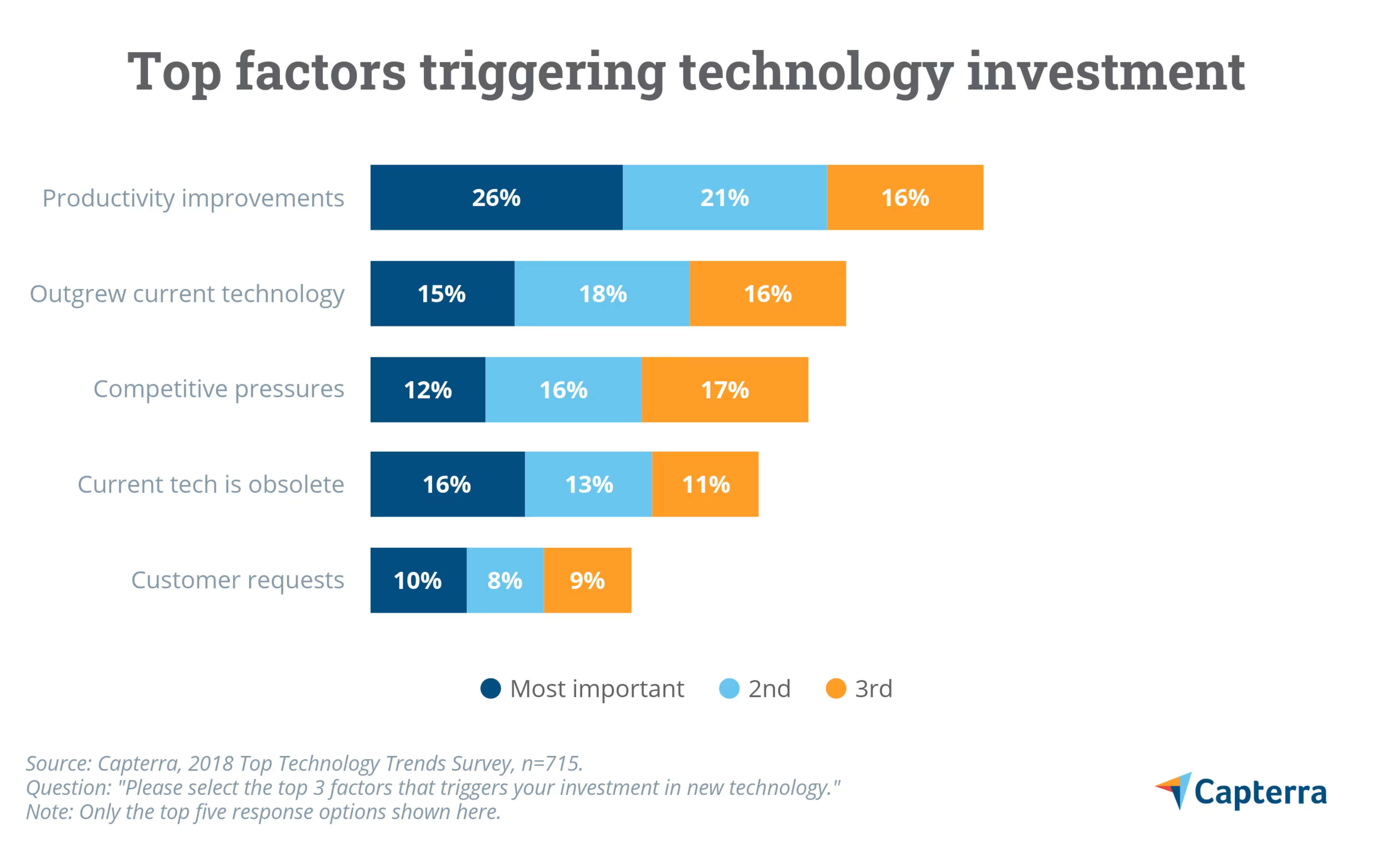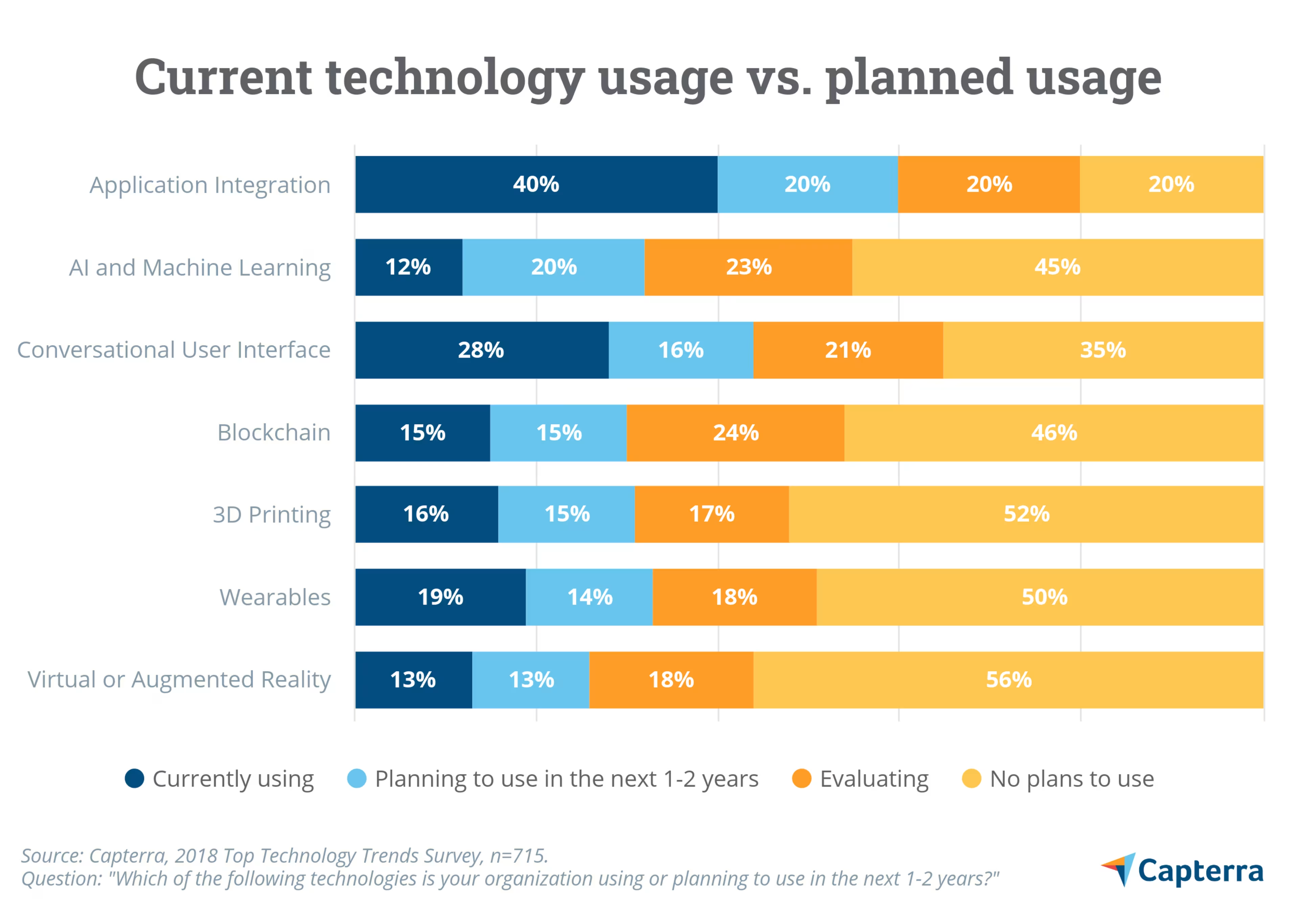What will the world look like in 2021?
Will George R.R. Martin finish writing his "Game of Thrones" series? Will Glenn Close finally win an Oscar? Will Brad and Jen ever get back together? It's impossible to predict what the future holds during these tumultuous times.
Where you might have more luck making predictions is with your business.

It's probably easier to answer a question like: What will your sales team look like in 2021?
The answer: Your sales team will be smaller by 2021. (See, it's not that hard.)
But it won't be because of fewer sales or decreased productivity. In fact, making the right technology investment will mean higher productivity with fewer people.
Technology will play a pivotal role in the future of sales, which should come as no surprise. The key here is having the “right" technology.
The future of sales means making the right investment
Realistically, most companies struggle to know which technology to invest in.
According to our recent survey of 715 U.S.-based small businesses, 50% of companies cite identifying the “right" technology as their biggest challenge when planning for investment.
But what makes a technology the “right" one? We're not talking relationships here; it's not a decision you make by listening to your heart or following your gut.
You need facts.
Knowing what your business goals are, how technology can help you achieve them, and what software and tools are available will help you find the right technological fit to set your sales team up for success into 2021, and beyond.
Let's take a look at three key findings from our survey and what they say about the future of sales to kickstart your tech-finding journey.
3 key findings from Capterra's small-business survey
1. Technology trends are integral to strategic planning
Businesses are starting to understand the importance that technology can play in their strategic business plans.
Just like planning inventory, resources, and headcount, planning for technology that can alter the way your company functions is a necessary reality given technology's rapid change rate and potential business impact.
Small businesses are already starting to think seriously about tech planning. More than 77% of survey respondents consider technology trends integral to their strategic planning.

Knowing not only what's happening now, but how technology is expected to affect the sales industry will be a huge advantage when planning your long-term business strategy.
Because sales teams are revenue drivers, sales managers should be particularly interested in how tech can reduce the need for more sales reps while streamlining processes and contributing to the business' bottom line.
The future of sales is: Fewer people, more technology.
Artificial intelligence (AI)-driven tools will automate tasks to free up human resources and allow sales reps to spend more time on selling, reducing the need to increase headcount.
Predictive analytics will give insight into sales data to allow for better predictions and resource planning, including if and when it's necessary to hire new sales reps.
Sales enablement tools will allow for better collaboration, alignment, and customer messaging between sales and marketing teams to drive sales without upping headcount.
2. Productivity is the top trigger for technology investment
Companies don't invest in tech for the adventure of adoption or the excitement of implementation. They invest in tech because they're facing a challenge that software can help combat.
If we want to get more granular, technology allows teams to carry out tasks that ultimately help advance business goals quicker and with less effort.

According to our research, the biggest driver of tech adoption is productivity improvement—63% of respondents named it as one of their top three triggers for tech investment.
This is especially important for sales teams, who spend as much as 65% of their time on non-revenue generating activities.
The right sales technology can make teams more productive by using automation to reduce the amount of time and effort spent on manual and menial tasks, especially with the help of AI.
The future of sales is: Less manual, more automated.
Sales force automation (SFA) tools automate manual tasks such as data entry and email outreach to free up your sales rep for more selling.
AI-based features find and score prospects to minimize reps' time spent on lead sourcing and scoring.
Sales monitoring and coaching features provide real-time insight into rep performance to quickly spot (and swiftly correct) problem areas.
3. AI, integration, and conversational UIs show the most growth potential
Having options can be a double-edged sword. Too few options might not provide you with what you really need, while too many can lead to analysis paralysis, making it impossible to choose.
The CRM market isn't short of options, but it's hard to know which software or features are the most important to keep sales teams on track well into 2021.
Here's the key: The shift toward more automation and more technology doesn't necessarily mean having more “stuff." It means being able to leverage the features in the products you're already using more effectively.
Take a look at this graph, which shows the technologies small businesses are using now, as well as what they're planning to use within the next two years:

Based on our survey results, AI and machine learning, application integration, and conversational user interfaces (UIs) show the biggest growth potential for sales teams looking to future-proof their sales activities.
The good news is that these technologies aren't mutually exclusive. You can invest in one piece of software that utilizes some or even all of these technologies to give you more functionality without having to adopt a bunch of different tools.
The future of sales is: Fewer products, more use cases.
Artificial intelligence is already incorporated into many different CRM and sales tools to automate tasks, optimize outreach, and predict future sales outcomes.
The same conversational UIs can be used by sales, marketing, and customer service teams to provide a more personalized experience by answering customer questions or directing customers to the right department.
Application integration ensures that the tools you are using are exchanging data and providing a holistic view of your customer for better targeting.
Bring your sales team into 2021
Okay, maybe I was a little ambitious when I said that your sales team will be smaller by 2021.
The right technology lets your sales team do more with less, but if sales really start flying, you'll likely still need to add extra reps to keep up with new accounts. Hiring and the right tech aren't mutually exclusive.
The future of sales is about making smarter hiring choices at opportune times and using technology to bridge the gap.
Here's how you can start using the right technology for your sales teams
Do your research: Explore the market to see what products are available that meet your needs. Create a checklist of “must-have" features that would help your team boost productivity and solve process bottlenecks that might be stagnating sales.
Plan ahead: Whether this comes from the top down or within your sales department, write down your strategic plan and yearly goals in a formal document. Include budgeting details—and based on your research—allocate a certain amount to tech investment for the year ahead. Make sure to keep your team in the loop.
Test different options: Tech investment is no joke. Make use of free trials and get your sales team to demo different software options before you decide on a tool.